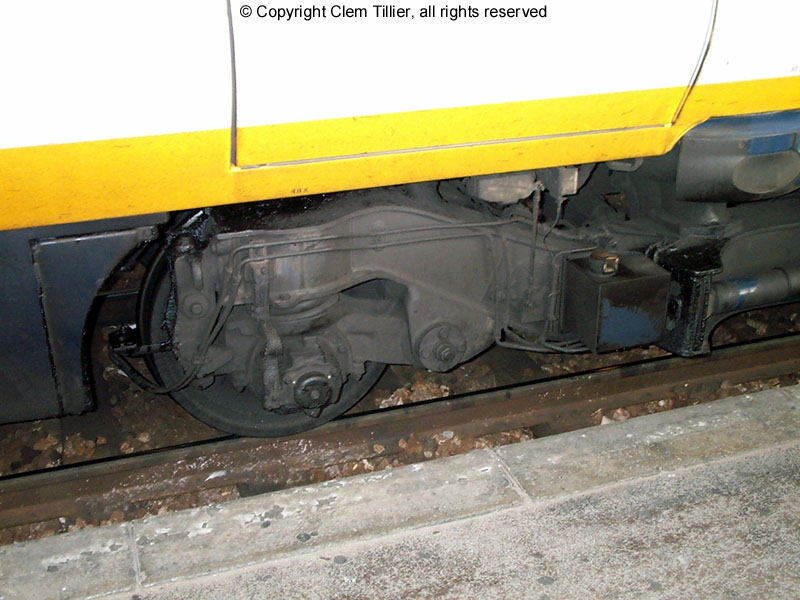How often are greasers used on train in US, and when they are used, are they on the cars or the locomotive? And if they are on the loco, is it standard equipment that comes with a new loco or is it something you have to install on your own?
Ya mean like Fonzie?
the Fonzie from the sitcom?
Yeah, that’s the Fonz.
As for the locomotive-mounted lubricators, that has generally been an after-market item, as far as I know, mounted on locomotives to lubricate the rails where the flanges (not the treads) of the wheels come in contact with the rail. Haven’t heard much about them lately, as track-mounted lubricators seem to do the job. They may get more play as fuel costs go up, though. Mudchicken may have a bit to say on this subject, too, as rail wear is supposedly reduced by such lubricants (by the way, it usually isn’t grease, but some sort of liquid lubricant).
And where would they be mounted on the locomotive? on the inside of wheels? outside? in front like sander?
Probably attached to the truck frames, to apply lubricant to the flanges.
I just checked the patent drawings for it.
It extracts lubricant on the top side of the wheel directly on the flange
Why would you have a “greaser” on the train? wouldn’t it just cause wheel slip?
Track mounted lubers are strategicaly located ahead of curves and stuff, they can squirt lube on the car wheels, that is where it is effective, not on the loco wheels as I see it.
Sand the engine wheels, lube the train wheels.
ps; I don’t think Fonzy worked for a railroad, maybe later in life he did, who knows.
Well it does exist.
I’ve been searching for more info on this and I’ve found that it’s used on some TGV trains
here it is:

Lubricating the flanges greatly reduces rail wear in sharp curves, and as long as too much isn’t used it shouldn’t affect adhesion too much. Since it reduces drag from the flanges it actually aids traction (as long as it doesn’t get to the tread area.
In theory, centifugal force should keep the lubricant off the tread.
Track mounted lubricators are also used near sharp curves, and these can be a problem for adhesion if they pump more lubricant than wanted.
M636C
They are very rarely used in N America. They would be special equipment.
There are also some systems that use a stick of lubricant (like a big “glue stick” only of a grease instead of glue).
In N America the stationary flange oiler is more common.
Dave H.
They are a little more common than you think. A big problem is that the mechanical departments are hard strapped to maintain them with limited forces. This caused considerable strife a few years ago at BNSF (3 way brawl) and I am told CN-IC. (EX: Better than 50% of the ex-Santa Fe GP60’s and SD60B’s had them installed as were a large group of SD70MAC’s, The grease reservoir is behind the second door behind the cab on the fireman’s side opposite the main generator)
Most railroads have gone back to trackside and hi-rail truck mounted systems in combination. Got your goop gauge?
The big issue is keeping the grease on the side of the rail and keeping it from getting up on top of the ball of the rail.
440 C:Those shiny new engines are absolutely worthless if you don’t take proper care of the rail that they run on. That includes friction management and rail profile grinding to extend rail life.
He was a mechanic, maybe he eventually went to work in a mechanical department of a railroad. [;)] Has anyone wondered why he could not just he the car that was in his shop and say “Aaaaaaaaaaaaaaaaaaaaaaaa” to fix it?
I recall seeing a video where 4449 was slipping like crazy due to the track lubricators.Needless to say,Doyle McCormack had more than a few choice words about them.
We use both the track mounted lube, and the truck mounted ones also.
The system on our MK1500Ds use the stick style lube…basicly a frame with a long stick of pariffin based grease, with the end of the stick pressed against the outside of the flange…more work that what they are worth in my opinion.
The track mounted lube system, when adjusted correctly, does a much better job, we have one mounted just ahead of the curve on my switching lead, helps slow down some of the wear in the outside rail of the curve.
Ed
Conrail put on board flange greasers on just about every road locomotive. The results were:
-
None of the manufacturer’s hardware was ready for North American Frt RRing. That is, it has to work all the time with almost no maintenance. Started out with Willey-Vogel system, wound up with TSM system.
-
It’s a big mess. It’s hard to keep the grease from going all over the underside of the locomotive and on to the steps.
-
It saves a several % in fuel, even on tangent track - more than engough to pay for the system and quite a bit of maintenance.
-
Mechanical pays for maintenance and Transportation for fuel, so guess what happened…
If I remember right the greaser is attached so that the flanges are oiled to aid going around curves, in practice they are not very usefull as the greaser has to installed in an inverted position so the greaser can reach the wheels, unfortunatly when this is done all the blood flows to the greasers head, they get dizzy and have to be changed every few miles, also despite all reports to the contrary, theres only so much grease thats concentrated in a greasers hair…
A better business was collecting greasers combs for recycling the grease buildup for conversion to fuel oil.